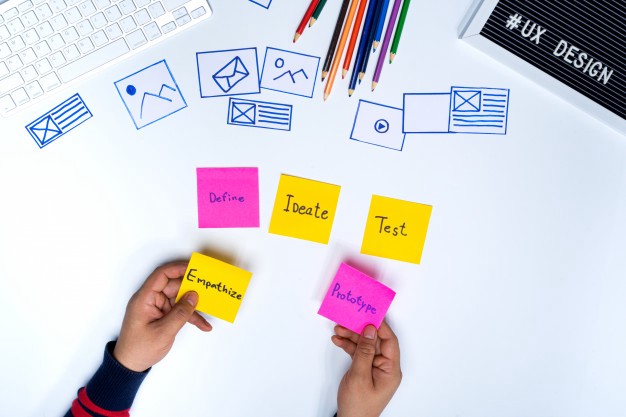
▲ Empathize → Define → Ideate → Prototype → Test
Design thinking is a “user-centered” approach to create more possibilities through user demands.
The creator of this method is the founder of the renowned American design company IDEO – David Kelley. Kelley transformed past experience in problem-solving in terms of the design thinking perspective into a master’s level course when he held the position of Director at the Stanford University’s Hasso Plattner Institute of Design, and established the academic position of “design thinking”.
IDEO CEO Tim Brown has also proposed the original definition in the Harvard Business Review “Design thinking is a human-centered design philosophy and approach that takes into consideration human needs and behavior, as well as technological and commercial feasibility.”
▲ Tim Brown during his 2009 TED Talk, in which he appeals to designers to shift into regional, cooperative, and participating “design thinking”.
How does one start with “design thinking”?
There are 5 stages in the process of “design thinking”: Empathize → Define → Ideate → Prototype → Test. After continuous and repeated testing and revisions through this 5-stage design process, we can achieve a more efficient product design that better matches the user’s needs.
1. Empathize
Empathize and think from the user’s point of view
Closely observe the user’s behavior and body language in daily life through “Observe, Engage, Watch and Listen” and accurately document the user’s experience and emotional feelings. Also, frequently ask “Why?” to find the user’s true needs.

▲ During the interview, frequently ask “Why?” to find the user’s true needs.
2. Define
Clearly define key issues
Categorize and organize the information acquired in the previous stage to discover the actual user needs and insight. Find the user’s “pain points” and define the user’s needs with a brief phrase.
The information from the Empathize Stage can be compiled in this stage using the “Point-of-View (POV) Madlib” approach, to be transformed into a problem description.
The contents of POV madlib: who is the user, what are the user’s needs, and why does the user have this need

▲ You can simply take down the user’s basic information with the user’s desires/fears attached
3. Ideate
Brain-storming, quickly ideate a solution
You can let your imagination run wild during this stage and propose any ideas that comes to mind without thinking about the feasibility or whether it can achieve the goal. The point is to explore as many different possibilities as possible.
It is also recommended to use post-its or the white board in this stage to capture everyone’s ideas on the wall. This method is convenient for everyone to browse the ideas and facilitates the subsequent voting process.

Pay special attention to absolutely avoid criticizing other team members’ ideas. There is a reason for everyone proposes his or her idea at the moment. Excessive individual criticism will only lead to an impact on the positivity and liveliness of team discussions.
After the Ideate Stage, you provide team members with small dot stickers for voting, and select 2 to 3 proposals with the highest number of dots to make prototypes.
4. Prototype
Create a prototype and simulate the process
In order to successfully “materialize” the ideas in your head, these prototypes provide as the most “quick and cheap” approach as possible, allowing for continuous revisions according to the feedback from team members or testers.
A thought simulation based on the lowest cost can minimize the time and money required due to failure and allow the team to boldly test different ideas.
A prototype is generally presented in a simple draft drawing (low cost and easily and conveniently fixed), which is continuously revised after communication and discussions to achieve an effect closer to perfection.

5. Test
Testing confirms if the user’s needs are met
Are the user’s needs resolved by reviewing the team’s prototype or solution through tests? The feedback from this stage can also be used to optimize the product, and conduce the backtracking process to iterate and update.
A user can test whether a prototype from stage 4 is suitable through scenario simulations. Observe the situation, response, and other aspects of the user using the prototype. Redefine the user demand solution based on the user feedback, and deepen our understanding of the user.
A test completion is not the ending of design thinking, but rather a new starting point for further iteration and update.
Iteration refers to returning to stage 2 to revise our defined details using the user feedback collected in stage 5, then redesigning the prototype of stage 4. Repeated revisions will allow our product to better match the user’s needs.
Conclusion
The “Design Thinking Process” described in this article can design products that better match the user’s needs and, more importantly, it allows team members who are less likely to speak up to successfully express their opinions.
During the “Ideate” Stage, the goal is for everyone to express their ideas, and to get as many ideas as possible. The tool involved is a post-it. Everyone takes one post-it to write their idea on and then stick it on the wall. This eliminates the step of oral expression, and almost everyone can speak freely.
This stage also prohibits mutual criticism between team members, which fosters a relatively safe and friendly environment, allowing ordinarily more introverted designers, PMs, and engineers to “speak their mind”.
After collecting the ideas, the post-its can be “categorized” (the method of categorization is by function or by needs). Everyone will explain their ideas, and then the voting process is conducted using round dot stickers. Further discussion can be continued by those ideas which get the most votes.
This is one aspect that I love about “Design Thinking”. It allows inarticulate team members to participate in discussions, and everyone with a small round dot sticker can vote, so that meetings are no longer dominated by people who are eloquent speakers.

Follow me on Instagram:https://www.instagram.com/out_of_design/
Follow me on Facebook Fan Pages:https://www.facebook.com/outofdesign0000/
Follow me on Vocus:https://vocus.cc/user/@outofdesign?page=1&tab=new
From “5 Stages of the ‘User’-Centered Design Thinking Process” by Chris Peng. Reprinted with permission by the author
